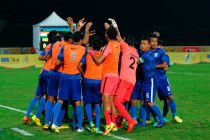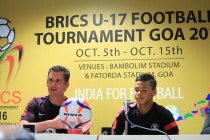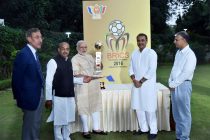All India Football Federation (AIFF) General Secretary Kushal Das shares his thoughts on a wide range of topics including the Hero Indian Super League (ISL), the 2017 FIFA Under-17 World Cup, grassroots development, international friendlies and a lot more.
Here are some excerpts from an exclusive interview with the Hero Indian Super League’s website www.indiansuperleague.com.
INTERVIEW
What is the philosophy behind the Indian Super League?
We are very optimistic that it will be hugely beneficial for Indian football. Over the last few years the AIFF is trying to develop the bottom of the pyramid. That means youth development and grassroots, and to a certain extent we have been successful. What we needed now is something of a top down approach, where there is visibility and obviously commerce for us to carry on the activity. I think the ISL is aimed exactly at that; visibility is created by the short tournament while bringing in commerce. These were lacking in Indian football.
India is going to host the FIFA Under-17 World Cup in 2017. What are your expectations?
The FIFA Under-17 World Cup project is intended to bring in the impetus for the youth of India, and to increase the visibility of Indian football. We have to take a long-term view – what is going to happen even after the event.
Do you think India’s attempt to host the FIFA Club World Cup will benefit Indian football?
Again, it’s a question of getting visibility and putting Indian football on the world map. In the FIFA Club World Cup, the host nation’s champion club gets a chance to participate and play with some of the big clubs and that’s a good experience.
Academies and grassroots development form the bottom of the ISL pyramid in eight cities. Do you think the horizons can be widened?
To start off with, eight cities are fine. Maybe, over the years, if things work out better, we can think of expanding it further. What is most important here is the obligation on the clubs to do grassroots development and later on create academies. We are going to work with the clubs very strongly and closely, to create and ensure that the philosophies of the AIFF grassroots programme and the clubs’ grassroots programmes sync together for the benefit of Indian football.
In the 1960s and 1970s, India were one of the powerhouses in Asia. Do you think that we can reclaim lost glory?
Absolutely. We have to admit that in 1960s things were different. A lot of Asian football countries did not have a well-developed football structure like Japan, South Korea and the West Asian countries. Over the years, we were slow in adapting to the modern methods of playing football and youth development programmes. In the seventies India used to beat Japan quite regularly but now it’s almost a dream. I think with these kinds of initiatives we can look forward to getting back the glory of the 1960s and 1970s. We can be a competitive team within Asia and even in the world.
How can the AIFF utilise the FIFA calendar for international friendlies in a better way?
We would like to play as many international matches as possible. Sometimes, the Indian calendar makes it a little difficult. Excluding the monsoons and summer, effectively, we have only six or seven months to play football. We try to play as many friendlies as possible, and hopefully going forward we will play more friendlies in the future.
The ISL and the I-League are already showing signs of co-existence. How will the I-League benefit from the ISL?
Two teams from the I-League are participating in the ISL, we have players from big clubs loaned to the ISL, and there is some association between clubs and ISL teams. In a way, six out of the ten I-League clubs have come into the ISL, which means that something like this will benefit Indian football as a whole, including the I-League clubs, in the long run.
Over the years we would like to have one solid league which goes on for six-seven months. Both can either co-exist or merge; already, there are indications of a collaboration between the I-League and ISL.
(Picture courtesy AIFF Media)









Follow me on Social Media